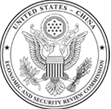×
Filter Results
Filter Results
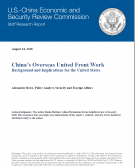
Staff Paper
China uses “United Front” work to co-opt and neutralize sources of potential opposition to the policies and authority of its ruling Chinese Communist Party (CCP). The CCP’s United Front Work Department (UFWD)—the agency responsible for coordinating these kinds of influence operations—mostly focuses on the management of potential opposition groups inside China, but it also has an important foreign influence mission. To carry out its influence activities abroad, the UFWD directs “overseas Chinese work,” which seeks to co-opt ethnic Chinese individuals and communities living outside China, while a number of other key affiliated organizations guided by China’s broader United Front strategy conduct influence operations targeting foreign actors and states. Some of these entities have clear connections to the CCP’s United Front strategy, while others’ linkage is less explicit. Today, United Front-related organizations are playing an increasingly important role in China’s broader foreign policy under Chinese President and General Secretary of the CCP Xi Jinping. It is precisely the nature of United Front work to seek influence through connections that are difficult to publically prove and to gain influence that is interwoven with sensitive issues such as ethnic, political, and national identity, making those who seek to identify the negative effects of such influence vulnerable to accusations of prejudice. Because of the complexities of this issue, it is crucial for the U.S. government to better understand Beijing’s United Front strategy, its goals, and the actors responsible for achieving them if it is to formulate an effective and comprehensive response.
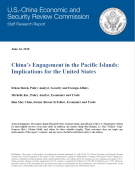
Staff Paper
Since President Xi took office in 2013, Beijing has significantly bolstered its involvement in the Pacific Islands region, which comprises three U.S. territories and three countries freely associated with the United States that are important for U.S. defense interests in the Indo-Pacific. Much of China’s engagement in the region has focused on expanding economic ties with the Pacific Islands, but it has also increased its footprint in the diplomatic and security realms. This report examines China’s interests in the region, its comprehensive engagement in the Pacific Islands, and the implications of its expanding presence and influence for the United States.
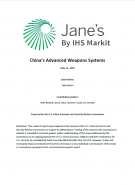
Contracted Research
The report examines five categories of China’s advanced weapons systems (counter-space, unmanned systems, maneuverable reentry vehicles, directed energy and electromagnetic railguns) and artificial intelligence applications for national defense. The report also assesses the implications of China’s advanced weapons programs for the United States and its allies and provides recommendations.
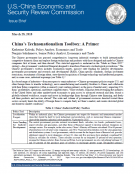
Issue Brief
The Chinese government has a comprehensive, long-term industrial strategy to build internationally competitive domestic firms and replace foreign technology and products with domestic equivalents first at home, and then abroad. This issue brief serves as a primer on the policies in the Chinese government’s toolbox for achieving its technonationalist targets, to include localization, massive subsidies for R&D, government procurement, China-specific standards, foreign investment restrictions, recruitment of foreign talent, state-directed acquisition of foreign technology and intellectual property, and, in some cases, industrial espionage.

Issue Brief
In November and December 2017, China’s People’s Liberation Army (PLA) Air Force conducted at least nine long-distance training flights over maritime areas along China’s periphery, continuing a trend that began in 2015. Since 2015, long-distance over-water training has become more frequent, featured a greater variety of aircraft, and extended into areas in which the air force had not previously operated. The long-distance over-water training is part of a broader PLA Air Force effort to transition from a service focused on territorial air defense to one capable of conducting offensive and defensive operations beyond China’s coast. These flight activities potentially challenge U.S. interests by (1) improving the PLA Air Force’s capability to execute maritime missions against the United States and U.S. allies and partners in the region; (2) gathering intelligence against the U.S. military and U.S. allies and partners; and (3) reinforcing claims in maritime disputes and pressuring Taiwan.
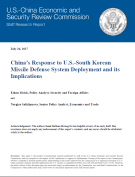
Staff Paper
In July 2016, the United States and South Korea announced the alliance decision to deploy a U.S. Terminal High Altitude Area Defense (THAAD) antimissile battery in South Korea to defend against the increasing North Korean missile threat. The move has angered Beijing, which perceives THAAD as mostly directed at China and a regional security concern, according to its official statements. In response, Beijing has used economic coercion, among other levers, to try to compel Seoul to abandon the THAAD deployment, but these efforts have proven unsuccessful. This report includes an overview of the THAAD system and its deployment, China’s stated concerns about THAAD, and China’s array of pressure directed against South Korea. It also examines the implications of China’s forceful response to the deployment for the United States and the geopolitical landscape in the Asia Pacific.

Staff Paper
Despite areas of tension and distrust between Beijing and Moscow since normalizing relations in 1989, the two countries’ militaries and defense establishments have steadily worked to minimize and overcome these differences and are now experiencing arguably the highest period of cooperation. This staff report analyzes the three main components of military-to-military ties—military exercises, defense industrial cooperation, and high-level military contacts—which show increases in the level and quality of engagement, collectively reflecting closer defense relations. The report also describes the security implications of recent developments in Sino-Russian defense cooperation for the United States and the Asia Pacific.

Staff Paper
China’s Beidou satellite navigation system—one of the country’s top space projects and only the fourth system of its kind currently in development or operation—is projected to achieve global coverage by 2020. This report examines the objectives behind Beijing’s decision to develop the system as an alternative to GPS, its efforts to build an industry around the system, and the effects this might have in security, economic, and diplomatic terms for the United States. The system’s primary purpose is to end China’s military reliance on GPS, although China’s associated industrial policies will likely affect U.S. firms operating in China’s market. Industry professionals assess there are no inherent risks to products such as smartphones receiving data from Beidou.
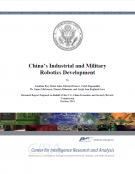
Contracted Research
The report examines the growth of China’s robotics industries and its development of unmanned industrial, service, and military systems, such as drones and driverless cars. The report assesses the economic and national security implications of these trends for the United States.
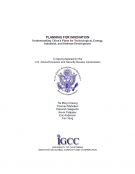
Contracted Research
The report provides an assessment of China’s state plans for civilian and defense-related science and technology, industrial, and energy development and their economic and security implications for the United States. The authors are Tai Ming Cheung, Thomas Mahnken, Deborah Seligsohn, Kevin Pollpeter, Eric Anderson, and Fan Yang, writing for the University of California Institute on Global Conflict and Cooperation.
